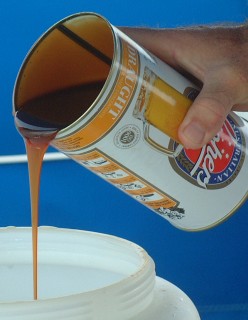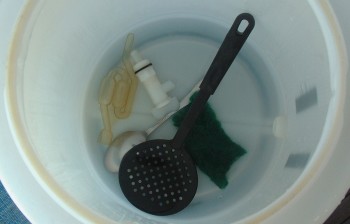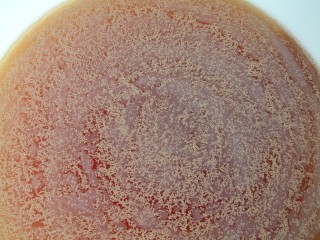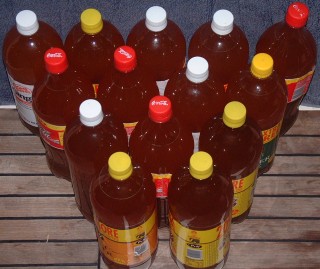
Coopers "Draught" malt-mix
|
Top Level Jon's Pages UpBrewing Pages |
Coopers Draught #2
 Coopers "Draught" malt-mix |
OK, it's Saturday "arvo" (afternoon) here in Darwin, Oz, and I've got a couple hours to burn before the Andersons arrive for dinner. My Draught and Bitter are almost finished and the Pale-Ale isn't really ready yet, so it's a great time to brew another batch. Problem is that most shops are closed and I've only got 4 kits on board at the moment: 3 Draughts and 1 Pale-Ale, so I guess this batch will be a Coopers Draught.
This is the first time I've repeated a brew. I'd like to say that we really liked the first Draught (and we did) but the truth is that it's easier to open a kit I already have on board than to find an open brew-store in sleepy little Darwin on a Saturday afternoon. However, in the interests of experimentation, I decided to use a slightly different sugar-mix than I did before. While my previous brews have usually used a dextrose and maltodextrin blend, I now have several bags of Coopers Brew-Enhancer #2, a dextrose, malt, and maltodextrin mix. Coopers doesn't specifically recommend its Brew-Enhancer #2 for its Draught, but I thought it might add a bit more body to this normally lighter beer.
 Spoons, spigot, water-trap & scrub-pad sterilizing in carboy |
Saturday, 15 July 2006 - Preparation:
We have access to water and facilities at the Darwin Sailing Club but
we're anchored a LONG way from shore, the 20' (6m) tides make
it a pain to haul the dinghy up the beach, and there's a bit of a surf
breaking today, so I decided to do this batch on board like my previous
Pale-Ale. My brew-master brother thinks
we should have our own private label, with a slogan like "brewed with only the
finest desalinated water!"
The fermenter, it's top, spigot, water-trap, and 2 large spoons were cleaned in brewers detergent, rinsed, then sterilized in a solution of sodium metabisulfite for about 30 minutes, and thoroughly rinsed again. I'm realizing that I need to give the sodium metabisulfite time to work, as my solutions are not too strong (I don't want the flavor to permeate my plastic fermenter).
 Despite sprinkling the yeast on top of the wort, it all sinks before fermentation can start |
Saturday, 15 July 2006 - Coopers Draught (again):
Now that these beers are seeming to work happily, I'm moving slowly away from
the standard beer recipes and trying to experiment a bit. Right now, I'm
trying to use fewer adjunct sugars and move to more malt, but a lighter beer
like this Draught needs a bit of sugar (see
sugar discussion). So I
decided to use Coopers Brew-Enhancer #2, a dextrose, malt, and maltodextrin mix,
instead of my standard dextrose and maltodextrin blend.
I put a bit of our fresh-squeezed (desalinated) water in the bottom of the fermenter, poured in a 1kg bag of Coopers Brew-Enhancer #2 and added the contents of the Coopers Draught malt-mix can. After scraping as much of the mix into the fermenter as I could with a large spoon, I added just a bit of boiling water to the can and swirled that around to dissolve the malt-mix that still clung to the walls of the can. This water was added to the fermenter and then more cool water was added while the wort was being continuously stirred. Once I had 23 litres (6 US gallons) I measured the specific gravity (1.040) and the yeast was sprinkled on top of the wort (and not stirred in). Then the top was screwed onto the fermenter and the water-trap was added. Final temperature was still a bit higher than I'd like (~82°F or 28°C) so I left it outside to cool down in the night air.
|
Sunday, 16 July 2006 - Fermenting:
Despite sprinkling the yeast on top of the wort, it had all settled to the
bottom by the time fermentation started, about 12 hours later. I'm trying
to slow the fermentation process down a bit by keeping the wort as cool as I can
in this warm climate. Longer fermentation times seem to produce
better beer. The days here in Darwin are quite pleasant, especially for
the dead of winter, but the air temperature can get up to ~86°F (30°C) and the
fermentation reaction is slightly exothermic (it generates its own heat).
Ideal fermentation temperatures are 70°-80°F (21°-27°C) so I leave the fermenter
outside in the breeze at night to cool down, and inside out of the sun during
the day.
 Amanda dosing bottles with dextrose |
However, fermentation effectively completed (no more bubbling out the water-trap) after about 3 days. We were busy careening Ocelot at the time, so I left the brew in the fermenter for a few days, which doesn't seem to harm it.
Friday, 21 July 2006 - Bottling:
Although we were madly charging around trying to get everything done before
leaving Darwin for Indonesia tomorrow(!!), we also didn't want to clean all the
beer bottles on Ocelot, as that step uses a lot of water. Since we
were doing 2 loads of laundry at the Sailing Club anyway, Amanda and Jon took
that opportunity to rinse, sterilize, and re-rinse 18 of our 1.5 liter bottles
in the club's laundry-room.
Bottling was done on Ocelot that night. Like some of my previous beers, taking the final specific gravity involved letting the sample sit for a while and then knocking the tiny bubbles off so I could get an accurate reading. With an initial specific gravity of 1.040 and a final of 1.009 (my lowest yet) the net alcoholic content should be about:
 Our second Draught harvest |
((1040-1009)/7.46) + .5 or about 4.7%.
I'm still experimenting with the correct amount of dextrose to use when dosing the bottles. While I don't need a lot of carbonation (indeed, a mildly carbonated beer is arguably more drinkable) I prefer a bit more than I've been getting so opened bottles don't go flat in the fridge. With my previous batch of Australian Pale Ale I added 20% more dextrose to increase the carbonation. Since we were using 1.5 liter bottles for this batch, Amanda added dextrose for 1.75 liters or about 17% more than called for.
In the end we harvested 14.5 x 1½ liter bottles for almost 22 liters of Draught. The yeast had settled completely and even the last bottle was the same color as the others. We stored them under Amanda's cabin sole so they could complete their carbonation fermentation in peace and darkness.
Brewing Pages:
Jon's Pages:
Top Level: Home | Destinations | Cruising Info | Underwater | Boat Guests | Ocelot | Sue | Jon | Amanda | Chris | Site Map | Make a Comment
|
If our information is useful, you can help by making a donation |
Copyright © 2000‑ Contact: Jon and Sue Hacking -- HackingFamily.com, svOcelot.com. All rights reserved.